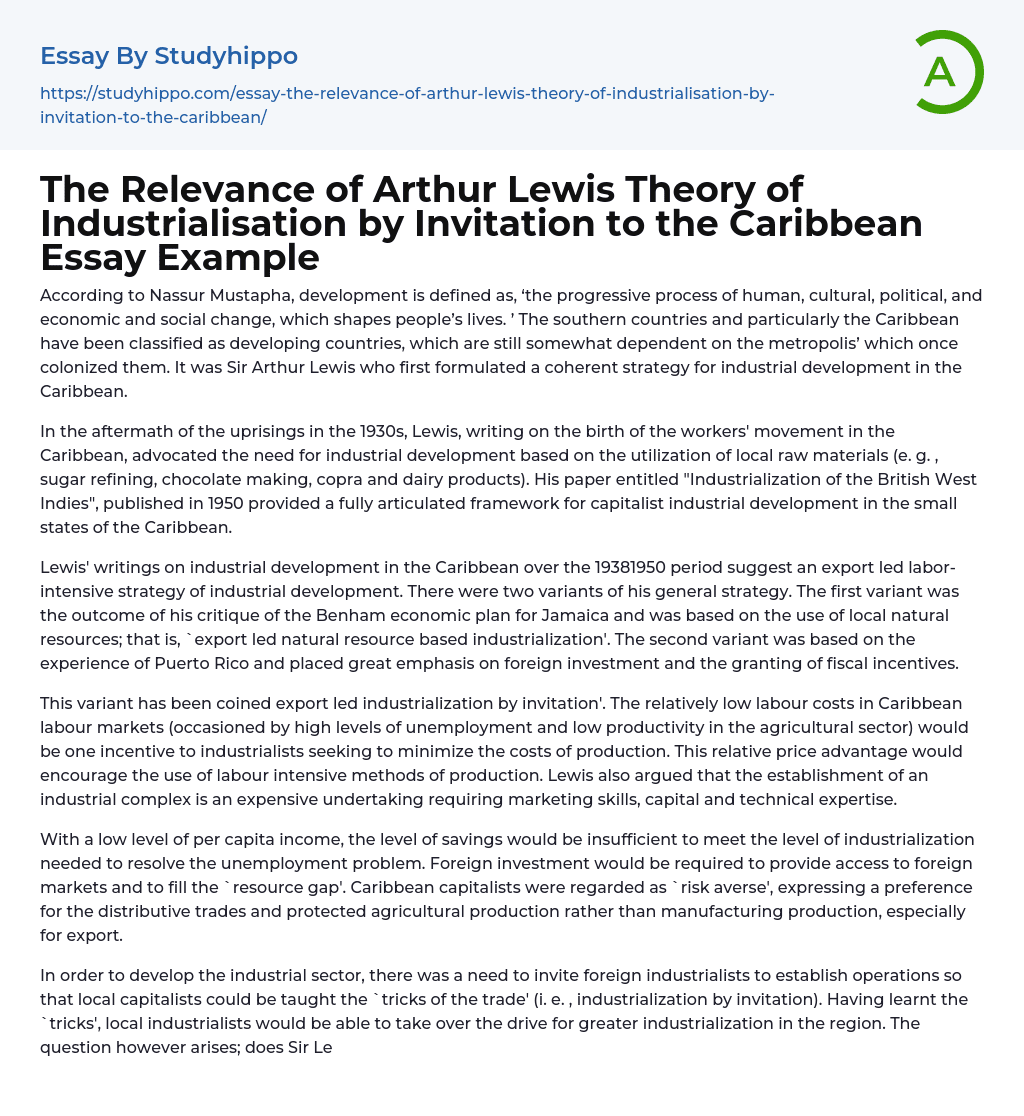According to Nassur Mustapha, development is defined as, ‘the progressive process of human, cultural, political, and economic and social change, which shapes people’s lives. ’ The southern countries and particularly the Caribbean have been classified as developing countries, which are still somewhat dependent on the metropolis’ which once colonized them. It was Sir Arthur Lewis who first formulated a coherent strategy for industrial development in the Caribbean.
In the aftermath of the uprisings in the 1930s, Lewis, writing on the birth of the workers' movement in the Caribbean, advocated the need for industrial development based on the utilization of local raw materials (e. g. , sugar refining, chocolate making, copra and dairy products). His paper entitled "Industrialization of the British West Indies", published in 1950 provided a fully articulated framework for capitalist industrial d
...evelopment in the small states of the Caribbean.
Lewis' writings on industrial development in the Caribbean over the 19381950 period suggest an export led labor-intensive strategy of industrial development. There were two variants of his general strategy. The first variant was the outcome of his critique of the Benham economic plan for Jamaica and was based on the use of local natural resources; that is, `export led natural resource based industrialization'. The second variant was based on the experience of Puerto Rico and placed great emphasis on foreign investment and the granting of fiscal incentives.
This variant has been coined export led industrialization by invitation'. The relatively low labour costs in Caribbean labour markets (occasioned by high levels of unemployment and low productivity in the agricultural sector) would be one incentive to industrialists seeking to minimize the
costs of production. This relative price advantage would encourage the use of labour intensive methods of production. Lewis also argued that the establishment of an industrial complex is an expensive undertaking requiring marketing skills, capital and technical expertise.
With a low level of per capita income, the level of savings would be insufficient to meet the level of industrialization needed to resolve the unemployment problem. Foreign investment would be required to provide access to foreign markets and to fill the `resource gap'. Caribbean capitalists were regarded as `risk averse', expressing a preference for the distributive trades and protected agricultural production rather than manufacturing production, especially for export.
In order to develop the industrial sector, there was a need to invite foreign industrialists to establish operations so that local capitalists could be taught the `tricks of the trade' (i. e. , industrialization by invitation). Having learnt the `tricks', local industrialists would be able to take over the drive for greater industrialization in the region. The question however arises; does Sir Lewis’ Model still apply today? Caribbean governments popularly adopted this policy in the 1960s.
Modern day, several foreign based companies that are established today in the Caribbean are the result of Sir Lewis’ policy. This is most apparent in the tourist industry; many foreigners have invested in hotels which employ the majority of people. In Antigua for example, 50% of the population is employed in the tourism industry. In addition to this, infrastructure such as roads and transportation has been developed by governments to complement these businesses.
Foreign investors have introduced the latest technologies and influenced the improvement of public services. The
policy fails in the modern British West Indies however, mainly because the Caribbean governments invited the MNCs but did not control them. In addition, most of the money earned by these investors is repatriated to their home countries, thus money is not invested in the economy; a grave issue with serious implications for the tourism industry. When the initial periods of tax-free holidays are up, these companies 'close up shop' and move on.
As they are mainly capital-intensive industries, thus virtually no provisions are usually made for training citizens to organize and run similar plants, such as the assembly of motor vehicles and small appliances, hence no sustainable development. In closing, the changes in the regional and international environments emphasize the need to increase productivity and improve international competitiveness. Caribbean countries must adjust to meet the challenges and opportunities created by the new economic environment.
Many commentators have looked to East Asia to identify the factors for successful industrialization and economic growth. For example, a World Bank study of the so-called `East Asian Miracle' maintains that “East Asian economies thrived because governments used a combination of fundamental and interventionist policies to (1) accumulate physical and human capital; (2) allocate this capital to highly productive investments; and (3) acquire and master technology and achieve rapid productivity growth".
Many of the measures used in these countries can be found in the work of Sir Arthur Lewis, namely, the building of human capital, the need to increase savings and domestic investment, government intervention, the use of foreign technology, the encouragement of export and the promotion of domestic entrepreneurship. Based on this information, it’s found that
if implemented properly, Arthur Lewis' “Industrialization by Invitation” Model can be highly relevant to Contemporary Caribbean society.
- American Dream essays
- Barriers To Entry essays
- Capitalism essays
- Central Bank essays
- Compensation essays
- Consumerism essays
- Economic Development essays
- Economic Growth essays
- Economic Inequality essays
- Economic System essays
- Economy essays
- Employment essays
- Export essays
- Finance essays
- Free Trade essays
- Gross Domestic Product essays
- Human Development essays
- Income Inequality essays
- Industry essays
- Inflation essays
- International Business essays
- International Trade essays
- Macroeconomics essays
- Materialism essays
- Max Weber essays
- Microeconomics essays
- Minimum Wage essays
- Monetary Policy essays
- Monopoly essays
- Pricing essays
- Profit essays
- Recession essays
- resources essays
- Taxation essays
- Trade essays
- Unemployment essays
- Warehouse essays
- World economy essays
- Experiment essays
- Explorer essays
- Hypothesis essays
- Observation essays
- Qualitative Research essays
- Research Methods essays
- Theory essays




